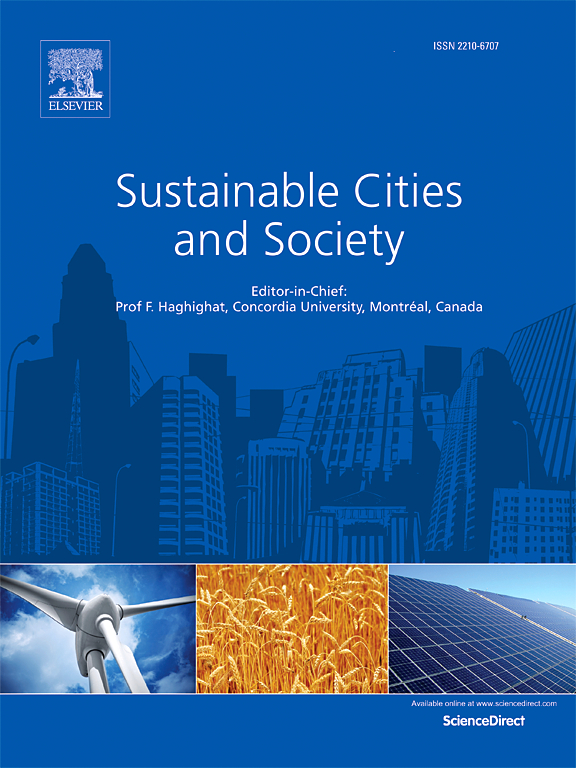Global sensitivity analysis in a complex 1D-2D coupled hydrodynamic model: Flood hazard and resilience perspectives over an urban catchment
IF 10.5
1区 工程技术
Q1 CONSTRUCTION & BUILDING TECHNOLOGY
引用次数: 0
Abstract
The increasing frequency of flood-related disasters has led to adopting advanced flood models to improve preparedness and response. To ensure reliable model outputs, conducting a Global Sensitivity Analysis (GSA) of model parameters is crucial. This study proposes a GSA framework for static input parameters in a 1D-2D coupled hydrodynamic flood model. MIKE-11 & MIKE-21 are coupled to simulate urban flooding in Mumbai's Mithi River catchment, considering rainfall and tidal influences. The model is simulated by perturbing various combinations of static input parameters to design test-scenarios. Outputs for an urban model setup are robust, complex, and gridded. Accordingly, GSA of static input parameters is also performed grid-wise to quantify sensitivity in terms of spatial variation of Flood Hazard and Flood Resilience across the catchment. Nonparametric probability density functions of flood depth at different locations are compared to calculate Kullback-Leibler divergence for quantifying sensitivity in the Flood Hazard context. Meanwhile, changes in Flood Resilience due to parameter perturbations are evaluated for resilience-based sensitivity. Results reveal varying impacts of input parameters across floodplain, with grid resolution and land use being most sensitive. The proposed novel GSA framework aligns with Sustainable Development Goal 11, aiming to make cities inclusive, safe, resilient, and sustainable, and equips flood management professionals with insights into key flood drivers, guiding data collection and monitoring. Proposed framework is versatile and can be integrated into any flood modeling software, offering resilient urban planning and risk mitigation strategies, contributing to sustainable urban development and better preparedness for flood risks in urban areas.

复杂一维-二维耦合水动力模型的全球敏感性分析:城市集水区洪水灾害和恢复力的视角
与洪水有关的灾害日益频繁,促使人们采用先进的洪水模型,以改进防灾和应对工作。为了确保可靠的模型输出,对模型参数进行全局敏感性分析(GSA)是至关重要的。本文提出了一维-二维耦合水动力洪水模型静态输入参数的GSA框架。MIKE-11,MIKE-21模拟了孟买米提河流域的城市洪水,考虑了降雨和潮汐的影响。通过扰动静态输入参数的不同组合对模型进行仿真,设计测试场景。城市模型设置的输出是鲁棒的、复杂的和网格化的。因此,静态输入参数的GSA也在网格上进行,以量化整个流域洪水危害和洪水恢复力的空间变化敏感性。通过比较不同地点洪水深度的非参数概率密度函数,计算库伦贝克-莱伯勒散度,以量化洪水灾害背景下的敏感性。同时,对参数扰动引起的洪水恢复力变化进行了基于恢复力敏感性的评估。结果表明,输入参数对河漫滩的影响各不相同,其中网格分辨率和土地利用最敏感。拟议的新型GSA框架与可持续发展目标11相一致,旨在使城市具有包容性、安全性、抗灾能力和可持续性,并为洪水管理专业人员提供对主要洪水驱动因素的见解,指导数据收集和监测。拟议的框架是多功能的,可以集成到任何洪水建模软件中,提供有弹性的城市规划和风险缓解战略,有助于可持续城市发展和更好地为城市地区的洪水风险做好准备。
本文章由计算机程序翻译,如有差异,请以英文原文为准。
求助全文
约1分钟内获得全文
求助全文
来源期刊

Sustainable Cities and Society
Social Sciences-Geography, Planning and Development
CiteScore
22.00
自引率
13.70%
发文量
810
审稿时长
27 days
期刊介绍:
Sustainable Cities and Society (SCS) is an international journal that focuses on fundamental and applied research to promote environmentally sustainable and socially resilient cities. The journal welcomes cross-cutting, multi-disciplinary research in various areas, including:
1. Smart cities and resilient environments;
2. Alternative/clean energy sources, energy distribution, distributed energy generation, and energy demand reduction/management;
3. Monitoring and improving air quality in built environment and cities (e.g., healthy built environment and air quality management);
4. Energy efficient, low/zero carbon, and green buildings/communities;
5. Climate change mitigation and adaptation in urban environments;
6. Green infrastructure and BMPs;
7. Environmental Footprint accounting and management;
8. Urban agriculture and forestry;
9. ICT, smart grid and intelligent infrastructure;
10. Urban design/planning, regulations, legislation, certification, economics, and policy;
11. Social aspects, impacts and resiliency of cities;
12. Behavior monitoring, analysis and change within urban communities;
13. Health monitoring and improvement;
14. Nexus issues related to sustainable cities and societies;
15. Smart city governance;
16. Decision Support Systems for trade-off and uncertainty analysis for improved management of cities and society;
17. Big data, machine learning, and artificial intelligence applications and case studies;
18. Critical infrastructure protection, including security, privacy, forensics, and reliability issues of cyber-physical systems.
19. Water footprint reduction and urban water distribution, harvesting, treatment, reuse and management;
20. Waste reduction and recycling;
21. Wastewater collection, treatment and recycling;
22. Smart, clean and healthy transportation systems and infrastructure;
 求助内容:
求助内容: 应助结果提醒方式:
应助结果提醒方式:


